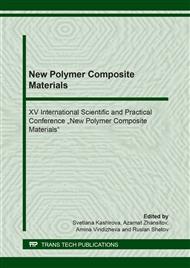p.219
p.228
p.233
p.238
p.244
p.250
p.255
p.260
p.266
Composites Based on Thermoplastic Polymeric Matrix and Carbon Nanoparticles with Special Functional Properties
Abstract:
Polymer composite materials based on polypropylene matrix and carbon nanoparticles of various shapes: spherical particles - carbon black and anisotropic nanoparticles - carbon nanofibers, were obtained by the melt technology. A character of the dependences of the electrical conductivities on the concentration of carbon nanofillers has been revealed. A simulation of the electrical conductivity of the polymer composite in the region of the concentration of the filler at the threshold of the flow of electric current and below it was carried out.
Info:
Periodical:
Pages:
244-249
Citation:
Online since:
August 2019
Authors:
Price:
Сopyright:
© 2019 Trans Tech Publications Ltd. All Rights Reserved
Share:
Citation:


